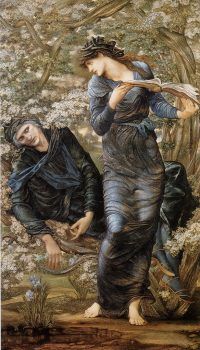Dominic Green at The New Criterion:
 The sublimities of light entertainment are comic—as when Lloyd Webber and Led Zeppelin strain for the serious but hit the timpani of hollow pomp, or when Wilde carves up the stuffed dummy of Victorian manners. And though the serious sublime is tragic, one age’s serious sublime becomes another’s comic entertainment. The Burne-Jones that Charles Blanc saw in The Beguiling of Merlin (1872–77) now seems proleptic of the 1970s, a decade in which William Morris wallpaper reappeared in English homes as if century-old designs, sleeping like Briar Rose under the layers of intervening taste, had been drawn to the surface like mold. Merlin’s socks and sandals, his Simple Life robe, and his black eyeshadow and pin eyes all anticipate an analogous rot, the decay of Arthurian legend into the grubby narcosis of an early Glastonbury Festival.
The sublimities of light entertainment are comic—as when Lloyd Webber and Led Zeppelin strain for the serious but hit the timpani of hollow pomp, or when Wilde carves up the stuffed dummy of Victorian manners. And though the serious sublime is tragic, one age’s serious sublime becomes another’s comic entertainment. The Burne-Jones that Charles Blanc saw in The Beguiling of Merlin (1872–77) now seems proleptic of the 1970s, a decade in which William Morris wallpaper reappeared in English homes as if century-old designs, sleeping like Briar Rose under the layers of intervening taste, had been drawn to the surface like mold. Merlin’s socks and sandals, his Simple Life robe, and his black eyeshadow and pin eyes all anticipate an analogous rot, the decay of Arthurian legend into the grubby narcosis of an early Glastonbury Festival.
The connection runs deep and direct. The “alternative lifestyle” that became a lucrative business of light entertainment in the 1960s, and which subsequently became the institutionalized lifestyle of the secular West, began in Burne-Jones’s youth and with people like Burne-Jones and his friends. The modern disease of “identity politics” originates in the Victorian cure of Lebensreform.
more here.
